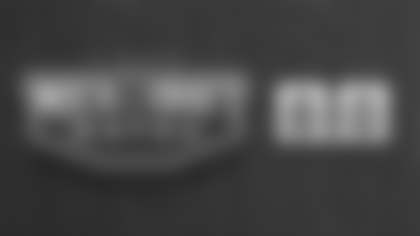Every summer leading up to training camp Buffalobills.com asks 25 of the most pressing questions facing the team as they make their final preparations for the upcoming regular season. With a new regime and practices at St. John Fisher fast approaching, here is the latest installment as we closely examine some of the answers the Buffalo Bills have to come up with between July 28th and Sept. 12th
The Bills transition back to the 3-4 front this offseason, which was a staple of their defense at the end of the last century, is going to bring a lot of change to Buffalo's defense in 2010. In the eyes of Chan Gailey, defensive coordinator George Edwards and the rest of the staff, it's hopefully change for the better.
Through the course of the offseason much has been made about how the multitude of different pre-snap looks that a defense can have in the 3-4 system should lead to more frequent opportunities to pressure the opposing quarterback. What's fallen by the wayside in that discussion by fans and analysts is the scheme's track record in defending the run.
Buffalo's recent history of run defense is nothing to be proud of. The previous decade yielded a pair of quality seasons in 2003 and 2004 when the run defense ranked in the top 10 and allowed just a shade over 100 rushing yards a game each season.
Since then Buffalo's best ranking was 22nd in 2008, but the Bills bottomed out for the decade just last season ranking 30th after permitting an astounding 156.3 yards on the ground each week. That figure was due in part to a number of factors, not all of which fell on the defensive side of the ball. With Buffalo's time of possession close to a league worst last season, the team's defensive unit usually spent more than half the game on the field.
So the question is will the 3-4 translate into better run defense?
The history of the 3-4 against the run is pretty sound provided a team has the personnel. Any coach will tell you talent is the number one priority. But looking at last year's top run defending teams, six of the top eight played 3-4 schemes. Even more encouraging is the fact that the league's best run defending team in 2009 was the Green Bay Packers, a team that was in year one of making the transition to a 3-4 front under Dom Capers.
The Packers went from a ranking of 26th in 2008 in a 4-3 to tops in the league in run defense in 2009 as they shaved almost 50 yards (48.3) off their average rushing yards allowed per game. They also cut their rushing touchdowns allowed from 20 to five over those two seasons.
"If you look at the trend that's gone on in the league, if you get the right guys in and play it right it seems like we should be able to stop the run and make more plays," said Paul Posluszny.
Granted Green Bay is just one example, and there are some poor run defenses in the NFL that operate out of a 3-4 alignment. But what the Packers recent success proves is turning a deficiency into a strength in a short period of time is possible.
"Change is good sometimes and it's a fresh start," said Kawika Mitchell. "Everybody is really committed to it right now and everybody who has been here understands that we need to win games. We have an opportunity to change what we've been doing in the past and hopefully make it better."
At the forefront of the new scheme, literally, is Kyle Williams. Coming off a breakout season in 2009, Williams will be anchoring the 3-4 front at the nose tackle position. He's not expected to be the traditional type nose tackle that Bills fans might recall in a player like Ted Washington, primarily because Williams is not a 360-pound man. But there are different roles in the league for nose tackles in 3-4 schemes.
"It depends on how you're going to play it," said Williams. "If you look at New England who two gaps everybody at the line, they have Wilfork who is 350 in the middle and they have big defensive ends. Teams like Arizona and Dallas play an over and an under front and two gap some. Their guys are 305 or 310 pounds at the nose and on the end they have lighter guys that can penetrate and get up the field."
On the surface it appears as though the Bills will play a mixture of both in 2010, with Williams' role likely to look somewhat like that of Cowboys nose tackle Jay Ratliff.
"There's a wide array of how guys play it," said Williams. "Ratliff in Dallas penetrates and stunts and then when he does two gap he surprises guys and knocks them in the backfield. Then you have Wilfork who is off the line of scrimmage a yard and just grabs guys and holds them up. There are different ways to play it."
What gives Williams greater confidence in the new 3-4 system is there is more margin for error than their previous scheme, especially when it comes to defending the run.
"That was the tough thing with what we had done in the past. We played a one gap defense and if one person is out of the gap it's a big play most of the time," he said. "It was hard to play off of each other because it was so rigid and you had to be here. This affords us a little more flexibility. Guys can come off and make plays, work off of each other where we couldn't do that in the past, and that's going to help us. Looking at it on the surface it looks like a really good deal for us and we're going to be able to play well."
Just the success within Buffalo's own division defensively with teams moving to new 3-4 systems has given Williams and his defensive teammates cause for optimism.
"I think if you look back at the last couple of years you see cases of teams going through overhauls, the Dolphins, the Jets last year," he said. "The Jets fell off and missed the playoffs (2008) and then this past year came to within one game of the Super Bowl.
"Everybody has got talented players. Almost all of our games last year, all but two or three were tied or within a field goal in the middle of the fourth quarter and we'd lose a lot of those games.
"Maybe this defense or a change of attitude is the difference in the fourth quarter and we win half of those football games and we go 9-7 or we go 10-6. Right now we're just working hard and learning the basics of the defense and we're trying to win those games in the fourth quarter rather than fade away and lose."
And if there's greater success in stopping the run the battle will be half won.





